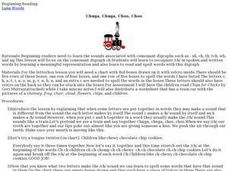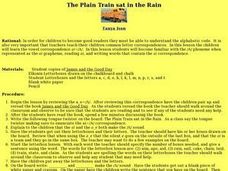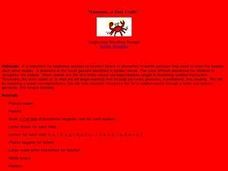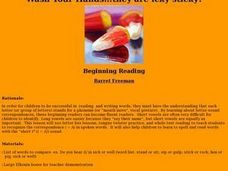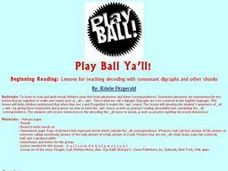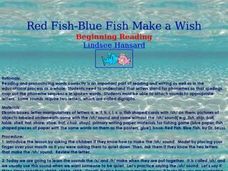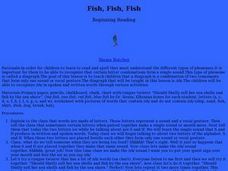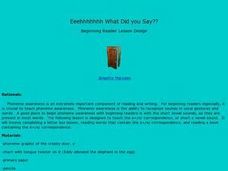Curated OER
Shhhhh
First graders identify the digraph /sh/ in written and spoken language. After a brief discussion of the independent and combined sounds of the phonemes /s/ and /h/ students practice identifying initial and final placement of the new...
Curated OER
Chuga Chuga Choo Choo
First graders identify the digraph /ch/ in written and spoken language. After a brief discussion of the independent and combined sounds of the phonemes /c/ and /h/ students practice identifying initial and final placement of the new...
Curated OER
Chug Choo Choo
First graders identify the digraph /ch/ in written and spoken language. After a brief discussion of the independent and combined sounds of the phonemes /c/ and /h/ students practice identifying initial and final placement of the new...
Curated OER
Don't Wake Mama
Students identify the digraph /sh/ in written and spoken language. After a brief discussion of the independent and combined sounds of the phonemes /s/ and /h/ students practice identifying initial and final placement of the new digraph...
Curated OER
Reintroduce /D/
Students study letters. In this letter identification lesson plan, students practice recognizing and pronouncing the letter "d." They work as a group to actively participate in various drills the teacher leads them through. This lesson...
Curated OER
Speedy, Speedy Students Reading Fast
Students review basic reading decoding. Given books at their independent reading level, they read independently and with several different partners to increase reading fluency. They see how many more words per minute they can read after...
Curated OER
The Plain Train sat in the Rain
Students study the ai=/A/ grapheme by reading "James and the Good Day" with a partner and discussing it. Next, they recite a tongue twister focusing on the ai=/A/ correspondence. They make words using their letterboxes and letters before...
Curated OER
Can You Open the Creaky Door?
Learners recognize the short vowel e in written and spoken language. Through matching and listening activities, they discriminate the vowel sound /e/ from other phonemes. Students identify the phoneme and letter in words and pictures.
Curated OER
E-E-E-E-Extra E-E-E-E-Effort
Young scholars listen to a tongue twister emphasizing the short e sound. They practice writing the letter e and attaching different words with that sound to it. They listen to a book about a dog that enhances the letter e. They write...
Curated OER
Icky Sticky
Students recognize the short vowel i in written and spoken language. Through matching and listening activities, they discriminate the vowel sound /i/ from other phonemes. Students identify the phoneme and letter in pseudo words they read.
Curated OER
The Squeaky Creaky Elevator
Students engage in an emergent literacy instructional activity in order to help develop the skills of letter recognition and corresponding sound of the phoneme. This is done with the use of a tongue twister using the phoneme of the...
Curated OER
Iiicky, Stiicky, I
First graders recognize the short vowel i in written and spoken language. Through listening and matching activities, they discriminate the vowel sound /i/ from other phonemes. Students identify the phoneme and letter in psuedo words they...
Curated OER
Load the Boat To Travel the Moat
Students discover that letters stand for phonemes. They determine that spellings map out the phonemes that are found in spoken words. They analyze the correspondence, oa = /O/ and recognize the /O/ sound in spoken and written words in...
Curated OER
O-o-o-oh, no-o-o-o!!
Learners engage in an emergent literacy lesson in order to practice the skill of phonemic awareness. They learn this skill using the phoneme for the letter "o". Students must recognize the letter as well as its sound.
Curated OER
"Aaaaaaa...a Fast Crab! "
Young scholars participate in an emergent literacy lesson that focuses on the skill of phonemic awareness. The phoneme chosen is the letter "a". They need to correlate the sound to the letter.
Curated OER
Wash Your Hands...they are icky sticky!
Students engage in an emergent literacy lesson that focuses on phonemic awareness and they practice corresponding the letter "i" to its long or short sound. This type of recognition has been found to be essential to reading development.
Curated OER
Play Ball Ya'll!
Students explore the /awl/ phoneme. They examine the /awl/ sound and how to make the sound themselves. They say /awl/ tongue twisters and use letterboxes to write several 'all' words. They read stories with the /awl/ sound.
Curated OER
Max's Magic Magnets
Pupils identify the letter and phoneme /m/ in written and spoken language. Students practice the production of the /m/ sound through tongue twisters and stories. They identify the initial placement of the letter and sound using a picture...
Curated OER
Red Fish-Blue Fish Make a Wish
Young scholars to read and pronounce words correctly. They investigate the letters that stand for phonemes so that spellings map out the phoneme sequence in spoken words. Students attach sounds to appropriate letters. They have some...
Curated OER
Fish, Fish, Fish
Students identify the digraph /sh/ in written and spoken language. After a brief discussion the independent and combined sounds of the phonemes /s/ and /h/ students practice identifying initial and final placement of the new digraph /sh/...
Curated OER
Eeehhhhhhh What Did you Say??
Student read pseudo words containing the e=/e/ correspondence and recognize sounds in vocal gestures and words. They explore the e=/e/ correspondence, or short e vowel sound and complete a letter box lesson plan, reading words that...
Curated OER
Jack the Fat Cat
Students recognize the short /a/ sound in written and spoken words in this instructional activity. They say a tongue twister which emphasizes words with the short /a/ sound. They then listen to the story "A Cat Nap" and identify the...
Curated OER
EA Words
Students determine if the "e" sound is long or short in words. In this language arts lesson, students practice discriminating between the long and short "e" sounds by practicing with word cards that are embedded in the lesson. This...
Curated OER
Shiny Shells on the Shore
Young scholars investigate how: A single phoneme, which is a vocal gesture in spoken words, can be represented by more than one grapheme. Also how a digraph is the combination of two letters that make one sound (there are both vowel and...

